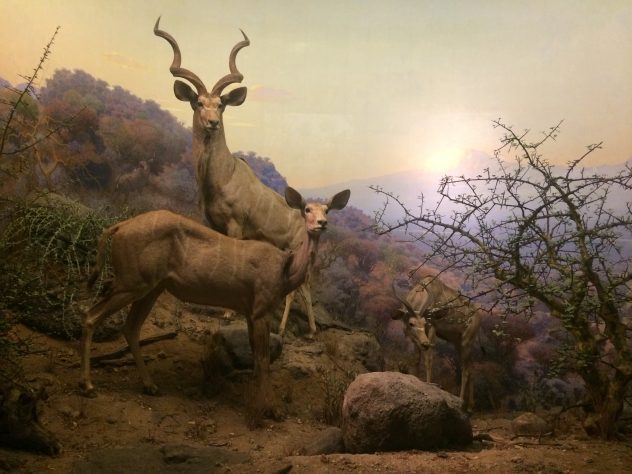My exhibit is located in the Hall of Mamals, which is typically the first hall you see and enter if you enter the mesuem through the main entrance. The plot of the exhbit is located in Africa, I don’t remember exactly which part. There are 3 Kudu’s present, one is behind the rock in what seems to be a searching position. While the other two are clearly visible and seems to be looking off in to the wild. The one with the spiraled horns is defineitly a male, while the other two are female. There isn’t much surrounding them besides hills of dirst and rocks. The trees barely seem to have anything on it and there just looks like patches of dry grass here and there.
| Greater Kudu quick facts | |
| Size: | Male:195 – 245 cm | Female 185 – 235 cm |
| Weight: | Male:190 – 315 kg | Female: 120 – 215 kg |
| Lifespan: | 7 to 8 years in the wild and up to 23 years in captivity |
| Habitat: | Dense bush or forest |
| Diet: | Herbivorous |
| Gestation: | Up to 9 months |
| Predators: | leopards, hunting dogs, spotted hyenas, humans |
What exactly is the Greater Kudu?
The greater kudu is a antelope that is extremely easy to distinguishe by the male’s beautiful spiral horns, which can reach lengths of over a meter. Another identifier of teh Greater Kudu is six to ten thin, pale stripes against its orange-brown or yellowish-brown color to grey-brown skin. The female greater kudu on the other hand, is much smaller than male, and lacks the impressive horns. The skin color of the female is also somewhat different from the male, varying from sandy yellowish-grey to reddish brown, against which the thin stripes are clearly legiable. Both sexes have a crest of hair that runs along the middle of the back, forming a mane, and there is a distinct white band across the face between the eyes.
Do they normally tavel in packs or alone?
The greater kudu stay in groups of up to 25 females and their offsprings. They constantly intermingling and separating. The larger male often roam more widely and form loose groups, usually only joining female herds during the mating season. The calves of the greater kudu are born in January and February. For the first three to four weeks, the calf lay hidden in vegetation, while the motherconstamtly visits to nurse it. Female calves remain with the mother’s herd, whereas males scatter after two years of age.
What do they typically feed on?
The greater kudu feeds on a range of foliage, herbs, vines, fruits, flowers and grass, its diet varies depending on the exact season. The long legs and neck of the kudu enable it to reach food at great heights hidden high up in trees.
Are these animals currently in any sort of danger from being extinct?
Hunting poses a threat to the greater kudu as it is prized for its beautiful horns and meat. Human encroachment and habitat destruction also play a detrimental impact. Populations of the greater kudu are also easily susceptible to outbreaks of disease, such as anthrax and rabies. This species is believed to be endangered in Somalia, Uganda, Chad and Kenya .

